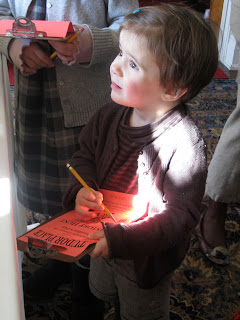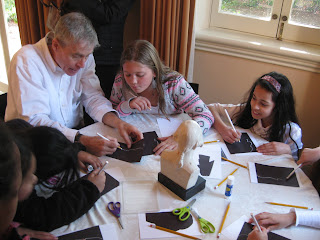By Haylee Wilson, Tudor Place Communications Intern
Stepping into George Washington’s shoes, Girl Scouts, Boy Scouts and other young people experienced life without apps, engines and appliances on Presidents’ Day. They joined more than 100 visitors of all ages in “Celebrating George” and his influence at Tudor Place, along with the chance to see Washington items of special significance on view just this one day each year. (The wider “Window on Washington” featuring displays of many Washington artifacts remains on view through March.)

The event provided a rare occasion to snack on period treats, try one’s hand at early American artwork, and stroll freely through the mansion with expert staff and docents on hand to highlight the Washingtons’ legacy here. During Presidents’ Day only, visitors could examine one of three surviving letters from George Washington to his wife, in which he bade her a fond farewell as he took up his Continental Army commission. Mrs. Washington’s handcrafted needlework was also on display for one day only, as was a famed miniature portrait of the first President, an engagement gift from him to his step-granddaughter, Martha Custis Peter — founding mistress of Tudor Place. — and one of the few portraits for which he personally sat.
Guests were met in the Conservatory with colorful baked goods made from period recipes, including Codling Apple Tarts, Hyson’s Green Tea, and Martha Washington’s own Great Cake (recipe follows this post).

Every child was invited to complete a scavenger hunt through the grounds, and its completion earned them small prizes. Our camera followed one set of scouts and families who, clipboards in hand, headed off after treats were finished for a little adventure.

Natural sunlight beaming through the windows lighted their way throughout the house as they searched for clues. First, they were introduced to appliances that residents used before the conveniences of electricity. They considered the absence of microwaves and freezers in the Peter family’s 1914 kitchen.
Scavenger hunters learned how, even in the absence of motorized tools, domestic workers pulled off elaborate dinners for the estate’s constant stream of guests and residents. In the absence of modern appliances, they recognized pots and pans and stoves, considering the different ways they were used before electricity changed household routines.
Moving into other areas of the house, boys and girls alike were fascinated with the network of bells and wires throughout the house that used to summon servants. As they explored the house, they searched for the cords in each room.

Traversing a gravel path through the North Garden, they next visited the Dower Townhouse, our administration building, for hands-on learning about the art of silhouette-making, a popular medium for early American portraits. Inspired by the images of America and Columbia Peter that flank the main house Drawing Room, and using a three-dimensional bust of our first President, Artist-in-Residence Peter Waddell demonstrated how to first sketch a profile.

Students drew and discussed the visual angles in various works of art before drawing profiles of George Washington, which they then cut out and placed on elegant white backgrounds. To further adorn their images, Peter taught them about differences in fonts, uses of capital letters, and the origin of serif lettering.

 Crossing back through the garden, the Pierce-Arrow Garage came next, where guests learned from “Martha Washington” herself how to have still more fun without electricity. She began with a lesson in dancing, explaining that Georgian-era style valued balance and symmetry.
Crossing back through the garden, the Pierce-Arrow Garage came next, where guests learned from “Martha Washington” herself how to have still more fun without electricity. She began with a lesson in dancing, explaining that Georgian-era style valued balance and symmetry. 
Mrs. Washington also introduced period games requiring no fancy boards, batteries, or sound effects. Building houses of cards, playing card games, and dominoes were among entertainments our guests had heard of.

Much of what children and families learned on Presidents’ Day encourages a commitment to sustainability. The Girl Scouts will use their new understanding on March 31, when they participate in
Earth Hour, a World Wildlife Fund initiative that creates awareness about climate change by asking participants to turn off the lights an hour. Families can also connect with nature and sustainability, in one of the city’s greenest spots during the popular annual
Earth Day at Tudor Place, Sunday, April 22. From 1 to 3 p.m., enjoy games, a themed scavenger hunt, and planting seeds from the historic garden in pots you decorate yourself.
Tudor Place offers additional events for visitors of all ages throughout the year, including educational programs for scouts, school groups, and homeschoolers. Visit us soon!
For still more photos from Presidents’ Day, and to add your comments on the day, see the
Facebook album. Good luck with the recipe below, and let us know how it turns out!
Martha Washington’s Great Cake
tweaked for the modern kitchen by curators at Mount Vernon
original
Take 40 eggs and divide the whites from the yolks and beat them to a froth. Then work 4 pounds of butter to a cream and put the whites of eggs to it a Spoon full at a time till it is well work’d. Then put 4 pounds of sugar finely powdered to it in the same manner then put in the Yolks of eggs and 5 pounds of flour and 5 pounds of fruit. 2 hours will bake it. Add to it half an ounce of mace and nutmeg half a pint of wine and some fresh brandy.
modern adaptationsIn making Martha Washington’s famed cake, Mount Vernon’s curatorial staff followed Mrs. Washington’s recipe almost exactly. Where the recipe called for 5 pounds of fruit, without specifying which ones, 2 pounds of raisins, 1 pound of currants, and 2 pounds of apples were used. The wine used was cream sherry. Since no one pan would hold so much batter, it was divided into two 14-inch layers, which were then stacked. (The cake in its original form would have been a single tall layer). These layers were baked in a 350-degree oven for 1.5 hours and iced with a very stiff egg-white-based icing flavored with rosewater or orange-flower water.








